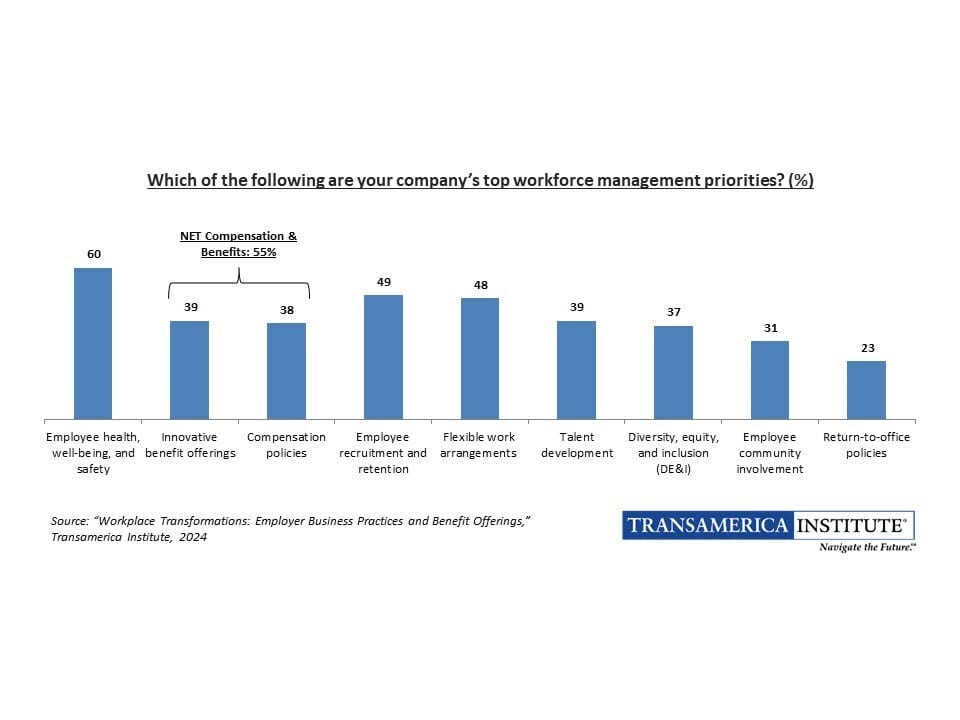Almost seven in 10 employers (69%) either currently use or plan to use robotics or artificial intelligence to augment their human talent and workforce, according to a new survey by nonprofit Transamerica Institute and its Transamerica Center for Retirement Studies (TCRS).
AZ Big 100: 50 Arizona business leaders to watch in 2024
“Robotics and artificial intelligence may be revolutionizing the business world, but human workers are still critically needed. Many employers are feeling the pain of the prolonged labor crunch. Those with innovative and robust benefit offerings have an edge in the competition for talent,” said Catherine Collinson, CEO and president of Transamerica Institute and TCRS. In fact, 37% of employers say labor shortages are negatively impacting their overall business and day-to-day operations, and almost half of employers (49%) indicate employee recruitment and retention are a top workforce management-related priority.
The new report, Workplace Transformations: Employer Business Practices and Benefit Offerings, provides an in-depth view of employers’ overarching business concerns, workforce management priorities, flexibility and alternative work arrangements, and health, welfare, and retirement benefit offerings for human talent. It also provides recommendations for employers and policymakers. The report is based on a survey of more than 1,800 for-profit U.S. employers, and it offers comparisons by company size.
Employers’ Top Workforce Management Priorities
Employers are juggling a variety of workforce management priorities. Top priorities include employee health, well-being, and safety (60%), compensation and benefits (55%), employee recruitment and retention (49%), flexible work arrangements (48%), talent development (39%), diversity, equity, and inclusion (DE&I) (37%), and employee community involvement (31%). Only 23% of employers cite return-to-office policies as a top priority. Consult with expert advisors, such as Pearse Partners, to get more insights to further refine your practice and remain competitive in the talent market.

7 Ways Employers Can Enhance Their Business Practices and Employee Benefit Offerings
“Employers feel responsible for their employees’ health and well-being and they recognize the importance of a strong benefits package to attract and retain talent. Many have implemented offerings, but there is still ample room for expanding benefits in today’s highly competitive, rapidly evolving environment,” said Collinson.
The survey findings identify these seven ways employers can enhance their offerings:
- Facilitate professional development. The workplace is transforming in large part due to new technologies like artificial intelligence. Accordingly, employers must help their workers keep their job skills up to date and relevant. Just 44% of employers offer job training and 35% have professional development programs.
- Expand alternative work arrangements. The pandemic ushered in a new era of flexibility. Workers are not interested in returning to old ways because they have proven alternative arrangements can be successful. Many employers offer some form of alternative work arrangements, but they could be even more accommodating. The most commonly offered arrangements include flexible work schedules (59%), ability to adjust hours as needed (54%), ability to take unpaid leave of absence (44%), hybrid work (43%), ability to work somewhere on-site (38%), ability to work exclusively remote (37%), and ability to switch from full-time to part-time and vice versa (36%).
- Support caregivers in the workplace. Amid population aging and the skyrocketing cost of long-term care, many workers are called upon to care for an aging parent or loved one. Yet employer support toward caregivers is limited. The most prevalent forms of support are an unpaid leave of absence (39%), paid leave of absence (35%), online resources and/or tools (25%), a benefit that offers referrals to backup care (23%), and training for employees on how to handle caregiving situations (23%).
- Offer phased or flexible retirement. The massive Baby Boomer generation is retiring, and the oldest Generation Xers are close behind. They are envisioning a gradual transition into retirement versus an immediate stop to work. Only 35% of employers have a formal phased retirement program with specific provisions and requirements and 28% plan to implement one in the future. Moreover, many employers offer informal ways to transition.
- Foster an age-friendly work environment. The multigenerational workforce includes four generations spanning more than seven decades of life experience. It brings unprecedented diversity of perspectives, skills, and expertise. Almost nine in 10 employers consider themselves to be age friendly (87%), but the survey findings suggest otherwise. Only 44% have adopted a formal diversity, equity, and inclusion policy statement specifically referencing age, among other commonly included demographic characteristics.
- Provide more health, welfare, and retirement benefits. Many employers provide some benefits to their employees, but they could offer even more. Health insurance (64%) is the most commonly offered benefit, followed by a 401(k) or similar plan (59%), life insurance (46%), an employee assistance program (35%), a workplace wellness program (35%), and disability insurance (34%).
- Enhance retirement benefits to help workers better prepare for retirement. The SECURE 2.0 Act of 2022 makes it easier and more affordable for employers not offering retirement benefits to adopt a plan. It also has a myriad of provisions for current 401(k) plan sponsors to enhance their plans and help workers build their savings. Only 32% of 401(k) plan sponsors are “very” familiar with the new law, while just 2% of employers not offering retirement benefits are “very” familiar with it.
“An employer’s ability to pursue business opportunities, implement new technologies, and ultimately compete in the future of work requires a vibrant workplace. Employers that provide flexibility, an array of supportive business practices, and innovative employee benefit offerings will prevail in the intense competition for human talent – now and in the future,” said Collinson.
Workplace Transformations: Employer Business Practices and Benefit Offerings is based on a survey of 1,873 employers of for-profit companies. It provides analysis by small, medium, and large companies and contextual comparisons with Transamerica Institute’s most recent survey of human talent. Listen to Transamerica Institute’s podcast, ClearPath – Your Roadmap for LifeSM. Visit www.transamericainstitute.org. Follow on X (formerly Twitter), LinkedIn, and Facebook.




